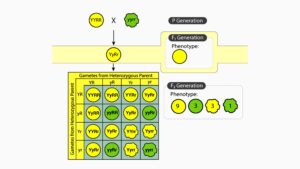Referred to as Mendel’s Second Law by Correns, The Law of Independent Assortment states that alleles from two pairs of traits segregate independently during gamete or spore formation.
Subsequently, they undergo random rearrangement during fertilization, giving rise to both parental and novel trait combinations.
Two crucial events occurs
- The independent separation of alleles for two pairs of traits during gamete or spore formation, and
- The random rearrangement of alleles (through a random union) in the offspring during fertilization.
The explanation of this law is often illustrated through a dihybrid cross, emphasizing the independent segregation and subsequent random recombination of alleles during inheritance.
Example of dyhybrid cross
In a dihybrid cross, a round yellow-seeded pea plant (RRYY) is crossed with a wrinkled green-seeded pea plant (rryy).
The dominant traits are round and yellow. The F1 generation is all round and yellow. When the F1 plants self-breed to produce the F2 generation, there’s a ratio of 9:3:3:1 for rounded yellow, rounded green, wrinkled yellow, and wrinkled green plants.
Notably, each trait, when considered separately, follows the classic 3:1 ratio seen in a monohybrid cross.
